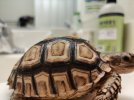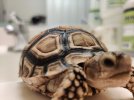mools
Member
It's been about 11 months with Walter. I got Walter maybe a few weeks after they hatched.
There seems to be slight pyramiding in middle top scutes of his carapace which is more apparent when looking from the side profile view. I'm a little concerned because the his sides seem quite smooth in comparison.
There seems to be slight pyramiding in middle top scutes of his carapace which is more apparent when looking from the side profile view. I'm a little concerned because the his sides seem quite smooth in comparison.




